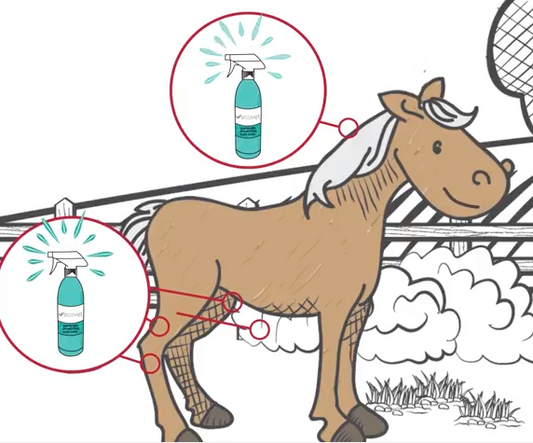Ecovet Blog
Here's a Fly We Actually Like!
Many thanks to Mina for sharing her experience using Ecovet on her aptly named gelding, Fly: "[I]t's the best fly spray I've ever used! Not a single thing touches my gelding....
Here's a Fly We Actually Like!
Many thanks to Mina for sharing her experience using Ecovet on her aptly named gelding, Fly: "[I]t's the best fly spray I've ever used! Not a single thing touches my gelding....

How to Apply Ecovet
Ecovet is an entirely different kind of fly spray – and you also apply it in a different way. To help you and your horse make the flies get lost,...
How to Apply Ecovet
Ecovet is an entirely different kind of fly spray – and you also apply it in a different way. To help you and your horse make the flies get lost,...

What's the Big Deal With Ticks on My Horse?
What are these strange parasites, and why are they on my horse? More importantly, how do I get rid of them? While fleas are essentially wingless flies, ticks are from...
What's the Big Deal With Ticks on My Horse?
What are these strange parasites, and why are they on my horse? More importantly, how do I get rid of them? While fleas are essentially wingless flies, ticks are from...
Ecovet Love From a Professional Groom
We were so pleased to receive this wonderful feedback about Ecovet fly spray from the good folks at ProEquineGrooms.com: "As a professional Groom, I understand the importance of reliable fly control...
Ecovet Love From a Professional Groom
We were so pleased to receive this wonderful feedback about Ecovet fly spray from the good folks at ProEquineGrooms.com: "As a professional Groom, I understand the importance of reliable fly control...
Helping the Allergic Horse
Fighting allergies is very frustrating. Unfortunately, we never really cure allergies but we can find ways to manage them. Horses can be allergic to a variety of things but Culicoides...
Helping the Allergic Horse
Fighting allergies is very frustrating. Unfortunately, we never really cure allergies but we can find ways to manage them. Horses can be allergic to a variety of things but Culicoides...
Before and After: Conga's Story
Ute from Ohio kindly shared these photos of her beautiful mare, Conga, before and after Ecovet. She says: “[My mare] was covered in bumps from bug bites. Applying the product...
Before and After: Conga's Story
Ute from Ohio kindly shared these photos of her beautiful mare, Conga, before and after Ecovet. She says: “[My mare] was covered in bumps from bug bites. Applying the product...
